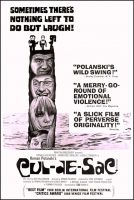Taglines: Sometimes there’s nothing better to do than laugh!
Cul-de-sac movie storyline. With the taste of failure in his mouth; on the run from the police, and with a dying accomplice in his hands, the wounded brute gangster, Dickie, will eventually discover the perfect hideout: a magnificent and seemingly deserted castle by the sea, now home of the feeble ex-factory owner, George, and his frivolous French wife, Teresa.
Home-invaded and forced to go along with Dickie’s orders, the unlikely fellowship will wait for the next morning to get help; instead, an unexpected visit from the obnoxious Fairweathers and their friends will be, indeed, the last straw. In the end, penniless, manipulated, and on the verge of a glorious emotional breakdown, the always coward George must–for once in his life–find the courage to defend his fortress, and his remaining dignity. But, has he the strength to do it?

Cul-de-sac is a 1966 British psychological comic thriller directed by the Polish director Roman Polanski. It was his second film in English, written by Polanski and Gérard Brach. The cast includes Donald Pleasence, Françoise Dorléac, Lionel Stander, Jack MacGowran, Iain Quarrier, Geoffrey Sumner, Renée Houston, William Franklyn, Trevor Delaney, Marie Kean. It also features Jacqueline Bisset (credited as Jackie Bisset) in a small role, in her second film appearance. The black and white cinematography is by Gil Taylor.
The film was shot on location in 1965 on the island of Lindisfarne (also known as Holy Island) off the coast of Northumberland, England. Lindisfarne Castle, which served as the home in the film, is now a National Trust property and can be toured by the public; despite the passage of time, the building and its surroundings are largely unchanged.
Like Polanski’s previous film Repulsion, released the year before, it explores themes of horror, frustrated sexuality and alienation, which have become characteristic of many of the director’s films, especially Rosemary’s Baby and The Tenant.
Cul-de-Sac has been compared in tone and theme with the works of Samuel Beckett and Harold Pinter, and these similarities are underscored by the casting of two principal roles in the film: Jack MacGowran was renowned for his stage performances of Beckett’s plays and Donald Pleasence originated the role of Davies in Pinter’s The Caretaker.
The film’s German title is Wenn Katelbach kommt (When Katelbach Comes). Christopher Weedman also notes the film’s similarities with “such hard-edged Humphrey Bogart hostage thrillers as The Petrified Forest (Archie Mayo, 1936), Key Largo (John Huston, 1948), and The Desperate Hours (William Wyler, 1955).”
Cul-de-sac (1966)
Directed by: Roman Polanski
Starring: Donald Pleasence, Françoise Dorléac, Lionel Stander, Jack MacGowran, Iain Quarrier, Geoffrey Sumner, Renée Houston, Robert Dorning, Marie Kean, William Franklyn, Jacqueline Bisset, Trevor Delaney
Screenplay by: Roman Polanski, Gerard Brach
Production Design by: Voytek
Cinematography by: Gilbert Taylor
Film Editing by: Alastair McIntyre
Art Direction by: George Lack
Makeup Department: Alan Brownie, Joyce James
Music by: Krzysztof Komeda
MPAA Rating: None.
Distributed by: Compton-Cameo Films (original UK release), Sigma III (original U.S. release)
Release Date: June 17, 1966 (London), November 7, 1966 (United States)
Views: 198


